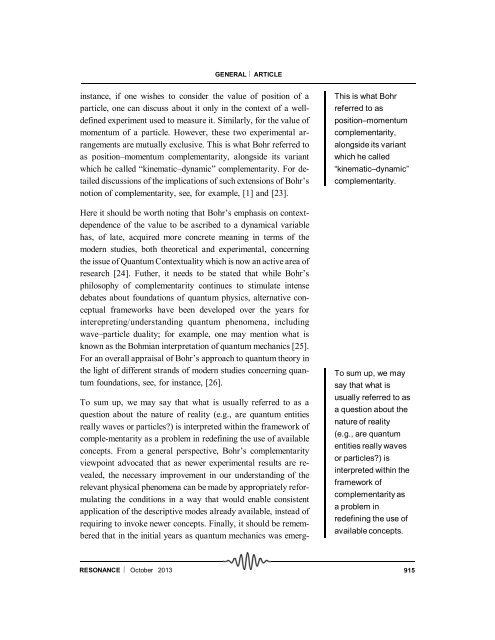Full Text(PDF)
Full Text(PDF)
Full Text(PDF)
You also want an ePaper? Increase the reach of your titles
YUMPU automatically turns print PDFs into web optimized ePapers that Google loves.
GENERAL ARTICLE<br />
instance, if one wishes to consider the value of position of a<br />
particle, one can discuss about it only in the context of a welldefined<br />
experiment used to measure it. Similarly, for the value of<br />
momentum of a particle. However, these two experimental arrangements<br />
are mutually exclusive. This is what Bohr referred to<br />
as position–momentum complementarity, alongside its variant<br />
which he called “kinematic–dynamic” complementarity. For detailed<br />
discussions of the implications of such extensions of Bohr’s<br />
notion of complementarity, see, for example, [1] and [23].<br />
Here it should be worth noting that Bohr’s emphasis on contextdependence<br />
of the value to be ascribed to a dynamical variable<br />
has, of late, acquired more concrete meaning in terms of the<br />
modern studies, both theoretical and experimental, concerning<br />
the issue of Quantum Contextuality which is now an active area of<br />
research [24]. Futher, it needs to be stated that while Bohr’s<br />
philosophy of complementarity continues to stimulate intense<br />
debates about foundations of quantum physics, alternative conceptual<br />
frameworks have been developed over the years for<br />
interepreting/understanding quantum phenomena, including<br />
wave–particle duality; for example, one may mention what is<br />
known as the Bohmian interpretation of quantum mechanics [25].<br />
For an overall appraisal of Bohr’s approach to quantum theory in<br />
the light of different strands of modern studies concerning quantum<br />
foundations, see, for instance, [26].<br />
To sum up, we may say that what is usually referred to as a<br />
question about the nature of reality (e.g., are quantum entities<br />
really waves or particles?) is interpreted within the framework of<br />
comple-mentarity as a problem in redefining the use of available<br />
concepts. From a general perspective, Bohr’s complementarity<br />
viewpoint advocated that as newer experimental results are revealed,<br />
the necessary improvement in our understanding of the<br />
relevant physical phenomena can be made by appropriately reformulating<br />
the conditions in a way that would enable consistent<br />
application of the descriptive modes already available, instead of<br />
requiring to invoke newer concepts. Finally, it should be remembered<br />
that in the initial years as quantum mechanics was emerg-<br />
This is what Bohr<br />
referred to as<br />
position–momentum<br />
complementarity,<br />
alongside its variant<br />
which he called<br />
“kinematic–dynamic”<br />
complementarity.<br />
To sum up, we may<br />
say that what is<br />
usually referred to as<br />
a question about the<br />
nature of reality<br />
(e.g., are quantum<br />
entities really waves<br />
or particles?) is<br />
interpreted within the<br />
framework of<br />
complementarityas<br />
a problem in<br />
redefining the use of<br />
available concepts.<br />
RESONANCE October 2013<br />
915
















